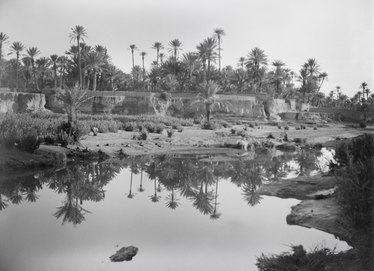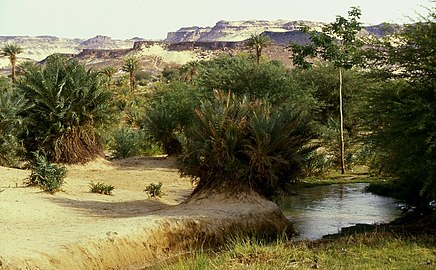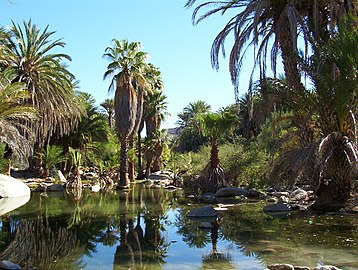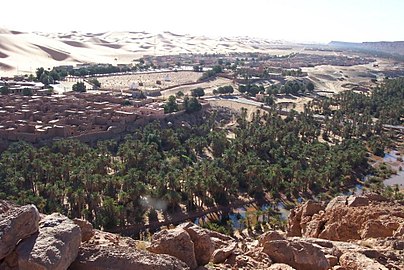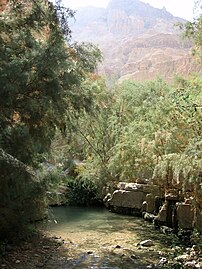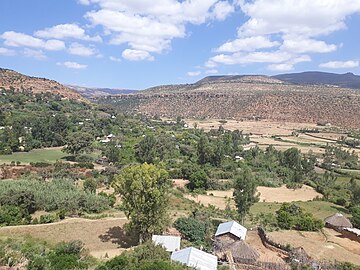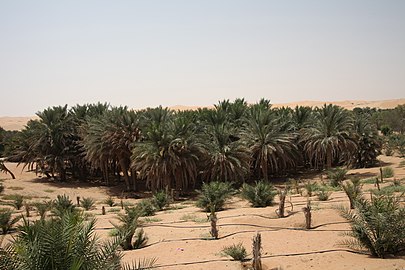
In ecology, an oasis (/oʊˈeɪsɪs/; PL: oases /oʊˈeɪsiːz/) is a fertile area of a desert or semi-desert environment that sustains plant life and provides habitat for animals. Surface water may be present, or water may only be accessible from wells or underground channels created by humans. In geography, an oasis may be a current or past rest stop on a transportation route, or less-than-verdant location that nonetheless provides access to underground water through deep wells created and maintained by humans.
The word oasis came into English from Latin: oasis, from Ancient Greek: ὄασις, óasis, which in turn is a direct borrowing from Demotic Egyptian. The word for oasis in the latter-attested Coptic language (the descendant of Demotic Egyptian) is wahe or ouahe which means a "dwelling place". Oasis in Arabic is wāḥa (Arabic: واحة).
Description
Oases develop in “hydrologically favored” locations that have attributes such as a high water table, seasonal lakes, or blockaded wadis. Oases are made when sources of freshwater, such as underground rivers or aquifers, irrigate the surface naturally or via man-made wells. The presence of water on the surface or underground is necessary and the local or regional management of this essential resource is strategic, but not sufficient to create such areas: continuous human work and know-how (a technical and social culture) are essential to maintain such ecosystems. Some of the possible human contributions to maintaining an oasis include digging and maintaining wells, digging and maintaining canals, and continuously removing opportunistic plants that threaten to gorge themselves on water and fertility needed to maintain human and animal food supplies. Stereotypically, an oasis has a “central pool of open water surrounded by a ring of water-dependent shrubs and trees…which are in turn encircled by an outlying transition zone to desert plants.”
Rain showers provide subterranean water to sustain natural oases, such as the Tuat. Substrata of impermeable rock and stone can trap water and retain it in pockets, or on long faulting subsurface ridges or volcanic dikes water can collect and percolate to the surface. Any incidence of water is then used by migrating birds, which also pass seeds with their droppings which will grow at the water's edge forming an oasis. It can also be used to plant crops.
Oases in the Middle East and North Africa cover about 1,000,000 hectares (10,000 km2), however, they support the livelihood of about 10 million inhabitants. The stark ratio of oasis to desert land in the world means that the oasis ecosystem is “relatively minute, rare and precious.”
There are 90 “major oases” within the Sahara Desert. Some of their fertility may derive from irrigation systems called foggaras, khettaras, lkhttarts, or a variety of other regional names.
In some oases systems, there is “a geometrical system of raised channels that release controlled amounts of the water into individual plots, soaking the soil.”

Oases often have human histories that are measured in millennia. Archeological digs at Ein Gedi in the Dead Sea Valley have found evidence of settlement dating to 6,000 BC. Al-Ahsa on the Arabian Peninsula shows evidence of human residence dating to the Neolithic.
Anthropologically, the oasis is “an area of sedentary life, which associates the city [medina] or village [ksar] with its surrounding feeding source, the palm grove, within a relational and circulatory nomadic system.”
The location of oases has been of critical importance for trade and transportation routes in desert areas; caravans must travel via oases so that supplies of water and food can be replenished. Thus, political or military control of an oasis has in many cases meant control of trade on a particular route. For example, the oases of Awjila, Ghadames and Kufra, situated in modern-day Libya, have at various times been vital to both north–south and east–west trade in the Sahara Desert. The location of oases also informed the Darb El Arba'īn trade route from Sudan to Egypt, as well as the caravan route from the Niger River to Tangier, Morocco. The Silk Road “traced its course from water hole to water hole, relying on oasis communities such as Turpan in China and Samarkand in Uzbekistan.”
According to the United Nations, “Oases are at the very heart of the overall development of peri-Saharan countries due to their geographical location and the fact they are preferred migration routes in times of famine or insecurity in the region.”
Oases in Oman, on the Arabian Peninsula near the Persian Gulf, vary somewhat from the Saharan form. While still located in an arid or semi-arid zone with a date palm overstory, these oases are usually located below plateaus and “watered either by springs or by aflaj, tunnel systems dug into the ground or carved into the rock to tap underground aquifers.” This rainwater harvesting system “never developed a serious salinity problem.”
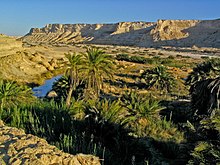

In the drylands of southwestern North America, there is a habitat form called Palm Oasis (alternately Palm Series or Oasis Scrub Woodland) that has the native California fan palm as the overstory species. These Palm Oases can be found in California, Arizona, Baja California, and Sonora.
Agroforestry

People who live in an oasis must manage land and water use carefully. The most important plant in an oasis is the date palm (Phoenix dactylifera L.), which forms the upper layer. These palm trees provide shade for smaller understory trees like apricots, dates, figs, olives, and peach trees, which form the middle layer. Market-garden vegetables, some cereals (such as sorghum, barley, millet, and wheat), and/or mixed animal fodder, are grown in the bottom layer where there is more moisture. The oasis is integrated into its desert environment through an often close association with nomadic transhumant livestock farming (very often pastoral and sedentary populations are clearly distinguished). The fertility of the oasis soil is restored by “cyclic organic inputs of animal origin.” In summary, an oasis palm grove is a highly anthropized and irrigated area that supports a traditionally intensive and polyculture-based agriculture.
Responding to environmental constraints, the three strata create what is called the "oasis effect." The three layers and all their interaction points create a variety of combinations of “horizontal wind speed, relative air temperature and relative air humidity.” The plantings—through a virtuous cycle of wind reduction, increased shade and evapotranspiration—create a microclimate favorable to crops; “measurements taken in different oases have showed that the potential evapotranspiration of the areas was reduced by 30 to 50 percent within the oasis.”
The keystone date palm trees are “a main income source and staple food for local populations in many countries in which they are cultivated, and have played significant roles in the economy, society, and environment of those countries.” Challenges for date palm oasis polycultures include “low rainfall, high temperatures, water resources often high in salt content, and high incidence of pests.”
The oases consist of almost unbroken forests of date palms, divided up into many gardens that are separated by mud walls and intersected by innumerable irrigation and drainage ditches… In the shade of the palms are grown many other kinds of fruit trees—oranges, olives, figs, apricots, peaches, pomegranates, and jujubes—interlaced with large grape vines that often hang in festoons from the palm trunks. Beneath the trees are small plots of garden vegetables, barley, and alfalfa. Neither date palms nor other trees are planted with any regularity, and the growth is often so dense that the garden resembles a tropical jungle. Very beautiful are these gardens in the spring, when the apricot and peach trees are in blossom here and there among the palms and the figs and vines are putting forth their leaves. In autumn, when the dates are ripening, the color effects, especially when the tops of the palms are lit up by the last rays of the setting sun, are something that once seen can never be forgotten. The great clusters of fruit, displaying every tint from bright yellow, through orange, vermilion, and maroon, to plum purple and chestnut brown, with their brilliant yellow or rich orange ivory-like stalks, contrast superbly with the dull bluish or gray green of the feathery crowns of foliage. It is small wonder that a whole folklore of poetic legends and proverbs has grown up around the date palm in the regions where it flourishes.
— Kearney, Thomas H. (1906-09-06). Bulletin: Date Varieties and Date Culture in Tunis.
Distressed systems
Many historic oases have struggled with drought and inadequate maintenance.
According to a United Nations report on the future of oases in the Sahara and Sahel, “Increasingly…oases are subject to various pressures, heavily influenced by the effects of climate change, decreasing groundwater levels and a gradual loss of cultural heritage due to a fading historical memory concerning traditional water management techniques. These natural pressures are compounded by demographic pressures and the introduction of modern water pumping techniques that can disrupt traditional resource management schemes, particularly in the North Saharan oases.”
For example, five historic oases in the Western Desert of Egypt (Kharga, Dakhla, Farafra, Baharyia, and Siwa) once had “flowing spring and wells” but due to the decline of groundwater heads because of overuse for land reclamation projects those water sources are no more and the oases suffer as a result.
Morocco has lost two-thirds of its oasis habitat over the last 100 years due to heat, drought, and water scarcity. The Ferkla Oases in Morocco once drew on water from the Ferkla, Sat and Tangarfa Rivers but they are now dry but for a few days a year.
List of places called oases
New World dryland systems with oasis-like attributes
- Huacachina, Peru
- Quitobaquito, Organ Pipe Cactus National Monument, Arizona
- Kitowok, Sonora, Mexico
- Fish Springs National Wildlife Refuge in Utah, United States
- Havasu Falls, Grand Canyon, Arizona
- Zzyzx in Mojave National Preserve, California
- Cuatro Ciengas basin, Chihuahuan desert, Mexico
- Oasis Spring Ecological Reserve, Salton Sea, California
Gallery of oases
-
Unidentified oasis in Africa, photographed c. 1930
-
Oasis de Santa Gertrudis, Baja California
-
Al-Ahsa Oasis, also known as Al-Hasa Oasis, in Saudi Arabia is the largest oasis in the world
-
Al Ain Oasis in the city of Al Ain in the United Arab Emirates
-
Rubaksa in a dry limestone environment in north Ethiopia is an oasis thanks to the existence of karstic springs
-
Ubari Oasis in southwestern Libya
-
Date palm trees in Liwa Oasis
-
Crescent Lake (Yueyaquan) in the Gobi Desert
-
Huacachina in southwestern Peru
-
Namibe desert oasis, Angola
Practical matters
A 1920 USGS publication about watering holes in the deserts of California and Arizona gave this advice for travelers seeking oases:
The usual watering places are springs or wells. Springs are frequently clogged with gravel or rubbish or sometimes even with the bodies of dead animals, and it may be necessary to clean them out. For this work a shovel is needed. Wells may or may not be equipped with pumps. Frequently the pumps are broken and useless, and a rope and bucket are then necessary to obtain water. Most of the wells in this region are less than 100 feet deep, but some are deeper, and 100 feet of rope is not too much to provide. As a rule the rope and bucket at a well, if they were ever provided, soon disappear, and one should never trust the chance of finding them there. Open wells are sometimes contaminated in the same way as springs and need to be cleaned out, particularly in little-frequented places where they are unused for months at a time.
